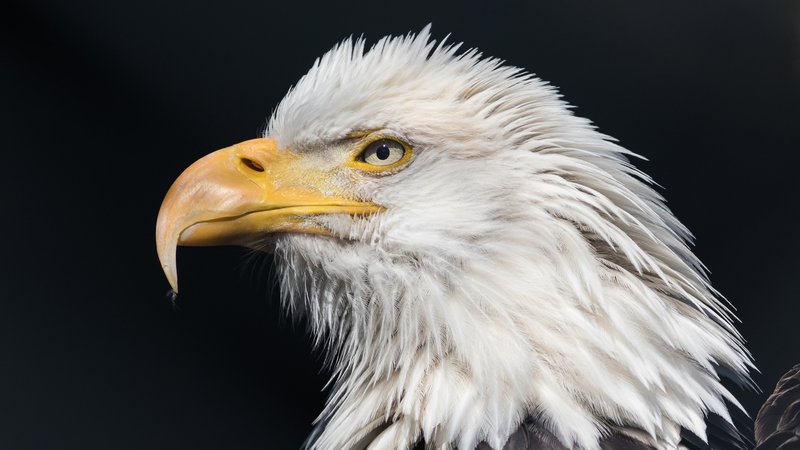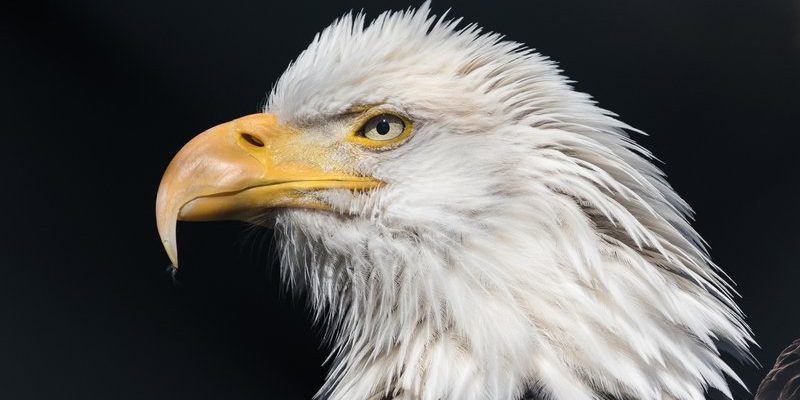
The Bald Eagle is a majestic bird that symbolizes strength and freedom, often associated with the United States. With its striking white head and tail feathers contrasted against a dark brown body, this bird of prey is easily recognized and admired by many. But there’s so much more to the Bald Eagle than just its looks! From its impressive wingspan to its unique hunting skills, the Bald Eagle captivates the hearts of wildlife enthusiasts and casual observers alike.
Imagine standing by a serene lake, the water perfectly reflecting the sky, and then catching a glimpse of a Bald Eagle soaring high above. This incredible predator can reach speeds of up to 35 miles per hour while flying and has sharp eyesight that allows it to spot its prey from great distances. With such powerful attributes, it’s no wonder that these birds are the epitome of grace and strength in the animal kingdom.
Physical Characteristics
The Bald Eagle boasts a striking appearance that makes it one of the most recognizable birds. Adult Bald Eagles typically have a wingspan of about 6 to 8 feet, making them one of the largest birds in North America. Their bodies are covered in dark brown feathers, while their heads and tails are pristine white, which develops around 4 to 5 years of age. Juveniles, on the other hand, sport a more uniform brown coloration and lack the iconic white feathers, which can make them a bit harder to identify at a glance.
Another fascinating feature of these birds is their sharp, hooked beak, which is designed for tearing flesh, and powerful talons that help them grab and hold onto slippery fish or other prey. They have keen eyesight, allowing them to see four to eight times better than humans, which is essential for spotting food from high in the sky. This combination of size, strength, and agility makes the Bald Eagle a formidable hunter.
Interestingly, the size of Bald Eagles can vary depending on their habitat and the availability of food. Eagles living in coastal areas tend to be larger than those in inland regions. This is linked to their diet primarily consisting of fish, which are more abundant in coastal habitats. So, the environment plays a significant role in shaping these magnificent birds!
Habitat and Distribution
Bald Eagles are found across North America, from Alaska to northern Mexico, favoring habitats near large bodies of open water with abundant food supplies and old-growth trees for nesting. They are particularly fond of rivers, lakes, and coastal regions where fish is plentiful. These habitats offer both food and safe nesting sites away from ground predators.
In terms of nesting, Bald Eagles construct large, often massive, stick nests that can be several feet in diameter. These nests are typically built high up in tall trees or on cliffs, providing a vantage point for both hunting and safety. Eagles often return to the same nest year after year, adding more material and sometimes creating nests that can weigh a ton! Imagine a fortress in the trees, carefully crafted over the years—it’s quite a sight.
However, habitat loss due to deforestation, pollution, and human encroachment has been a significant threat to Bald Eagle populations. Conservation efforts have made a difference, leading to a remarkable recovery in their numbers, but the health of their habitats remains crucial to their continued survival.
Diet and Hunting Behavior
The Bald Eagle is primarily a carnivore, feeding mainly on fish, which makes up about 70% of its diet. Using their incredible eyesight, they can spot fish swimming near the surface of the water. Once they identify their target, they swoop down with great speed, extending their powerful talons to seize their catch. It’s as if they’re executing a perfectly timed dive! They are also known to steal fish from other birds, like ospreys, when the opportunity arises, showcasing their opportunistic feeding behavior.
Besides fish, Bald Eagles will eat a variety of other prey, including small mammals, birds, and carrion. Their diverse diet allows them to adapt to different environments and food availability, which is essential for survival. In times of scarcity, they’ve been known to hunt larger prey, such as rabbits or even small deer. Their adaptability is just one of the many traits that help them thrive in various habitats.
Hunting is not just about speed and strength; it’s also about strategy. Bald Eagles tend to hunt alone or in pairs and have been observed working together to catch larger prey. They use their keen sense of observation and patience, often perching in trees to scout for food. You might say they have the patience of saints when waiting for the perfect moment to strike!
Reproductive Behavior
The Bald Eagle’s breeding season usually occurs in late winter to early spring. During courtship, males perform aerial displays, including diving and swooping, to impress potential mates. Once a pair forms a bond, they often mate for life, returning to the same nesting site year after year. Nesting starts with the female laying one to three eggs, which both parents take turns incubating for about 35 days.
After hatching, the eaglets are incredibly vulnerable and rely entirely on their parents for food and protection. The parents bring fish and small mammals to the nest, feeding the young until they can fend for themselves. These young birds grow quickly and start to fledge, or leave the nest, at around 10 to 12 weeks old. It’s a thrilling time for the family, as the eaglets take their first flights into the world!
Interestingly, not all eaglets survive. Sometimes, siblings may compete for food, leading to what’s known as “siblicide,” where the stronger baby may push the weaker one out of the nest. While harsh, this natural behavior ensures that the strongest genes are passed down. Nature has a way of balancing things, doesn’t it?
Conservation Status
The Bald Eagle faced significant decline during the 20th century due to hunting, habitat destruction, and the effects of pesticide use, particularly DDT. This led to a drastic drop in their population, resulting in their listing as an endangered species in the United States in 1967. However, thanks to concerted conservation efforts, including legal protection and habitat restoration, Bald Eagle numbers have rebounded dramatically.
In 2007, the U.S. government formally removed the Bald Eagle from the endangered species list, marking a significant victory for wildlife conservation. Today, the population is estimated to be over 300,000 birds, which is a remarkable recovery. It’s a testament to what focused efforts can achieve in protecting our natural heritage and wildlife!
Despite this success, challenges remain. Continued threats from habitat loss, climate change, and human activities pose risks to their future. Conservationists emphasize the importance of ongoing awareness and protection of the Bald Eagle and its habitats to ensure that they remain a symbol of freedom for generations to come.
| Attribute | Details |
| Wingspan | 6 to 8 feet |
| Weight | 3 to 6.3 kg (6.6 to 14 lbs) |
| Habitat | Near large bodies of water, forests, and coastal regions |
| Diet | Primarily fish, also small mammals and carrion |
| Lifespan | 20 to 30 years in the wild |
| Speed | Up to 35 mph when flying |
FAQ
What do Bald Eagles eat?
Bald Eagles primarily eat fish, which makes up around 70% of their diet. They will also consume small mammals, birds, and carrion when fish is scarce. Their impressive hunting skills help them catch their preferred food, but they’re also known to scavenge fish from other birds when the opportunity arises.
Where do Bald Eagles build their nests?
Bald Eagles typically build their nests in tall trees or on cliffs near large bodies of water. They prefer areas with plenty of food supply and old-growth trees. Their nests are often large and can be reused each year, which means they can grow quite massive over time.
How long do Bald Eagles live?
In the wild, Bald Eagles generally live between 20 to 30 years. However, this lifespan can vary based on environmental conditions and threats they face, such as habitat loss, food scarcity, and human interference.
Are Bald Eagles endangered?
As of now, Bald Eagles are no longer considered endangered. They were removed from the endangered species list in 2007 due to successful conservation efforts. However, they still face ongoing threats that require continued monitoring and protection.
Can Bald Eagles see in color?
Yes, Bald Eagles can see colors, and their vision is much sharper than that of humans. They can see four to eight times better than we can, which is crucial for spotting prey from great distances. Their excellent eyesight helps them thrive as hunters.
How fast can a Bald Eagle fly?
Bald Eagles can reach speeds of up to 35 miles per hour when flying. During a dive, they can go even faster, showcasing their impressive physical abilities and agility in the air.
Do Bald Eagles mate for life?
Yes, Bald Eagles often mate for life. Once a pair forms a bond, they typically stay together, returning to the same nesting site each year for breeding. This strong bond is vital for raising their young and ensuring the survival of their species.
What is the significance of the Bald Eagle in American culture?
The Bald Eagle is a powerful symbol in American culture, representing freedom, strength, and resilience. It has been the national bird and emblem of the United States since 1782. Its image is featured on the Great Seal of the United States and numerous government logos, making it an enduring symbol of the nation’s values.
How do Bald Eagles communicate?
Bald Eagles communicate through a variety of vocalizations, including high-pitched whistles and chirps. These sounds help them establish territory, attract mates, and communicate with their young. The calls and sounds they make are integral to their social interactions and overall behavior.
What challenges do Bald Eagles face?
Bald Eagles face several challenges, including habitat loss, climate change, and pollution. Conservation efforts continue to be essential to address these issues and protect the species for future generations. Awareness and action are crucial in ensuring that these magnificent birds can thrive in the wild.
Can Bald Eagles swim?
While they are primarily birds of prey, Bald Eagles can swim if necessary. They will sometimes do this to escape danger or when retrieving prey from the water. Their strong wings allow them to paddle, albeit not as gracefully as typical waterfowl.

